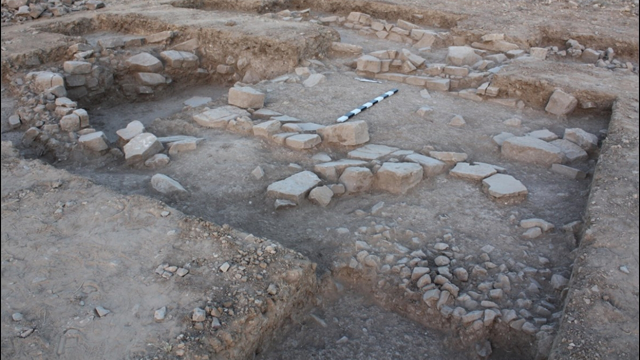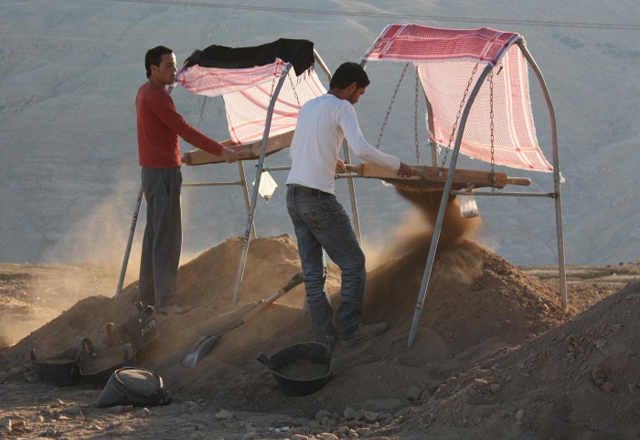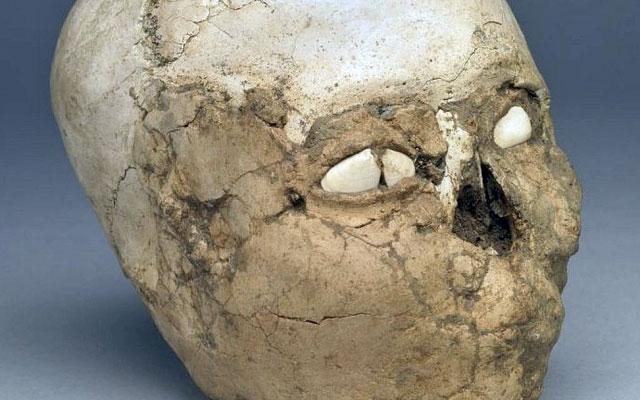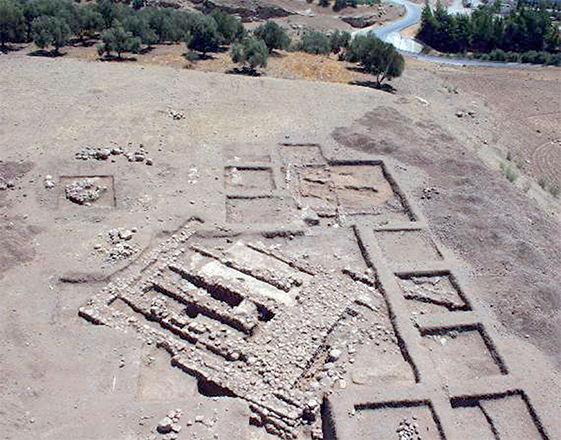You are here
About Khayran's unique role in Pre-Pottery Neolithic settlement patterns
By Saeb Rawashdeh - Sep 30,2024 - Last updated at Sep 30,2024

Remains of the structure at al-Khayran, with the cobblestone and flagstone surfaces visible in the foreground and the walls visible in the background (Photo courtesy of Matthew Kroot)
AMMAN — Khayran is a site located on the southern ridge of Wadi Assal in the west-central Transjordanian Highlands. It is placed under the Lisan Peninsula and consists of a single structure constructed and reconstructed in two phases, as well as associated refuse dating to the Pre-Pottery Neolithic B (PPNB). The site is characterised by knapped-stone technology. Knapping is the shaping of flint, chert, obsidian, or other conchoidal fracturing stone through the process of lithic reduction to manufacture stone tools.
The site was a model for research that focused on agricultural economies and communities that practiced husbandry and domestication of plants and animals.
"However, scholars have identified ways in which these challenges can be overcome, mostly focused on the intensification of subsistence production allowing for higher productivity and more even access to food," said Matthew Kroot from Arizona State University.
“If resources necessary for production must be acquired through social interactions, such as labour recruitment or specialist-produced tools, then settlement aggregation is a common response as it allows producers efficient access to the provisioners of their needed resources,” Kroot explained, adding other researchers have emphasised the social barriers to the development of primarily agricultural economies.
“Bowles and Choi note that food sharing practices common in many small-scale societies disincentivise the husbandry of resource,” the archaeologist pointed out, noting that this is because the redistribution of outputs greatly reduces any potential benefits for individuals who incur the high costs of agricultural intensification.
"Similarly, relations of production that prevent transgenerational control of subsistence production discourage intensification through investments in landesque capital. Production units are typically intergenerational and thus, those who bear the cost of such investments will lose their benefits eventually when they do not inherit the means of production into which they have invested," Kroot outlined.
Khayran was occupied in at least two different episodes, with significant labour and materials expended constructing a residential structure with thick stone walls, multiple types of durable prepared surfaces, and inset architectural features, the scholar elaborated, adding that the knapped stone assemblage likely reflects a broad range of on-site activities, showing a wide array of formal tool types, the entire reduction sequence from core production through tool rejuvenation, and expedient tool use in substantial numbers.
"The fauna assemblage and considerable number of sickle blades show that during their occupation of the Khayran site, residents enacted a variety of subsistence production and consumption activities. Overall, this behavioural reconstruction presents an occupational picture similar to that of a typical household of the agricultural village-based populations of the southern Levantine Mediterranean zone during the PPNB," Kroot explained.
However, Khayran is highly unique, being the first site identified in the region with only a single solidly constructed and intensively occupied residential structure with material remains attesting to typical household function for the period. Within the southern Levantine PPNB Mediterranean zone are several known non-village sites. However, these do not contain residential architecture as substantially and elaborately built as Khayran, nor do they contain the broad spectrum of material culture associated with village-based household function.
Instead, they tend to serve such roles as mortuary and ritual sites or to be the location of specialised economic activities, such as flint mining or seasonal hunting, Kroot said.
Small sites are also found in the more arid regions bordering on the southern Levantine Mediterranean zone in the south and east. However, these sites are dissimilar to Khayran in form, content and function – the most notable difference being the use of circular residential architecture across the desert zones of the Southern Levant.
"Additionally, many sites contain no or minimally elaborated residential architecture, while those that do contain extensively built architecture are far larger in scale than Khayran. Further analysis of Khayran can help us understand the settlement systems, subsistence production practices and economic relations that underpin the unique results from the site within its broader regional context during the development of agricultural village-based life," Kroot underlined.
According to a scholar, there are two possible interpretations of Khayran: a small farmstead for a single residential unit or an agricultural field house occupied by a village-based residential unit.
"The first of these, a small farmstead, would suggest that there was a greater diversity of residential behaviours in the southern Levantine Mediterranean zone than previously documented, with at least some settlement decisions being driven by the labour demands developing during the shift towards agriculturally based subsistence systems, " Kroot said, noting that if Khayran is a field house, it would also broaden our picture of residential behaviour in the PPNB.
“Khayran shows that residential practices and communities were more varied than previously known for the PPNB,” Kroot concluded.
Related Articles
AMMAN — Located near the Lisan Peninsula, in the southern part of the Dead Sea shore, Khayran dates to about 10,000 years ago in a tim
AMMAN — The removal and modification of skulls in the Levant was documented for the first time during the Natufian period around 11,000 year
AMMAN — Located some 500 metres from the old Amman-Jerash road, Tell Abu Suwwan represents one of the Neolithic mega sites whose occupation

















